Vietnam, a nation shaped by dramatic history and breathtaking landscapes, stretches over 2,000 miles, offering an incredible tapestry of experiences. With a population nearing 100 million, its vibrant energy is palpable, from bustling metropolises to tranquil mountain villages and pristine islands. Having first visited in 2004 and returned numerous times, I’ve witnessed its transformation while its core charm endures. While the well-trodden path through Hanoi, Halong Bay, Hoi An, and Ho Chi Minh City is rewarding, venturing further reveals truly dazzling and unforgettable moments.
My most cherished experiences have come from exploring the less-visited corners – a multi-day cruise into the remote reaches of Halong Bay, a challenging yet exhilarating motorbike journey through the dramatic karst peaks of Ha Giang, or a poignant visit to the last wild elephant catcher in Yok Don National Park.
Discovering the elaborate imperial tombs of Hue deepened my appreciation for Vietnam’s dynastic past, spotting the rare Cat Ba langur on Cat Ba Island was a thrill, and exploring the history, food, and stunning beaches of Con Dao Island offered a profound connection to its complex story. And always, the irresistible, fragrant food, rich coffee, creative cocktails, and local beer serve as delightful guides, leading you to discover the heart and soul of each region. If you’re planning your journey and wondering “Where To Go In Vietnam,” this guide is for you.
Planning Your Vietnam Adventure: How Long Do You Need?
Deciding where to go in Vietnam often depends on your available time. The country is long, and travel between regions can take time, whether by plane, train, or bus. Balancing major highlights with slower exploration is key to a fulfilling trip.
With just one week, focus on the north: Hanoi’s historic charm, a boat trip to the iconic Halong Bay, and the peaceful rice fields of the Mai Chau Valley offer a diverse introduction. For a two-week journey, build on the first week by adding central Vietnam’s historical richness and coastal beauty (Hue, DMZ, My Son ruins, Hoi An) before concluding in the energetic southern hub of Ho Chi Minh City. Getting around involves a mix of domestic flights and overnight trains, which are experiences in themselves.
Finding Your Perfect Amateur Astronomy Telescope – Expert Guide 2025
Discover the Best Michigan Places to Visit for Unforgettable Adventures in 2024
Discover the Top 11 nevada places to visit
If you have the luxury of three weeks or more, you can delve deeper into specific regions like the far north’s Ha Giang, the cool Central Highlands around Dalat, the spectacular caves of Phong Nha-Ke Bang National Park, enjoy a dedicated beach break, or explore the waterways of the Mekong Delta and the unique history and nature of Con Dao island. For those on a tight budget, balancing economical domestic flights with long-distance train journeys and Vietnam’s extensive network of air-conditioned “open ticket” buses is a practical approach.
Hanoi: A Tapestry of History and Modern Life
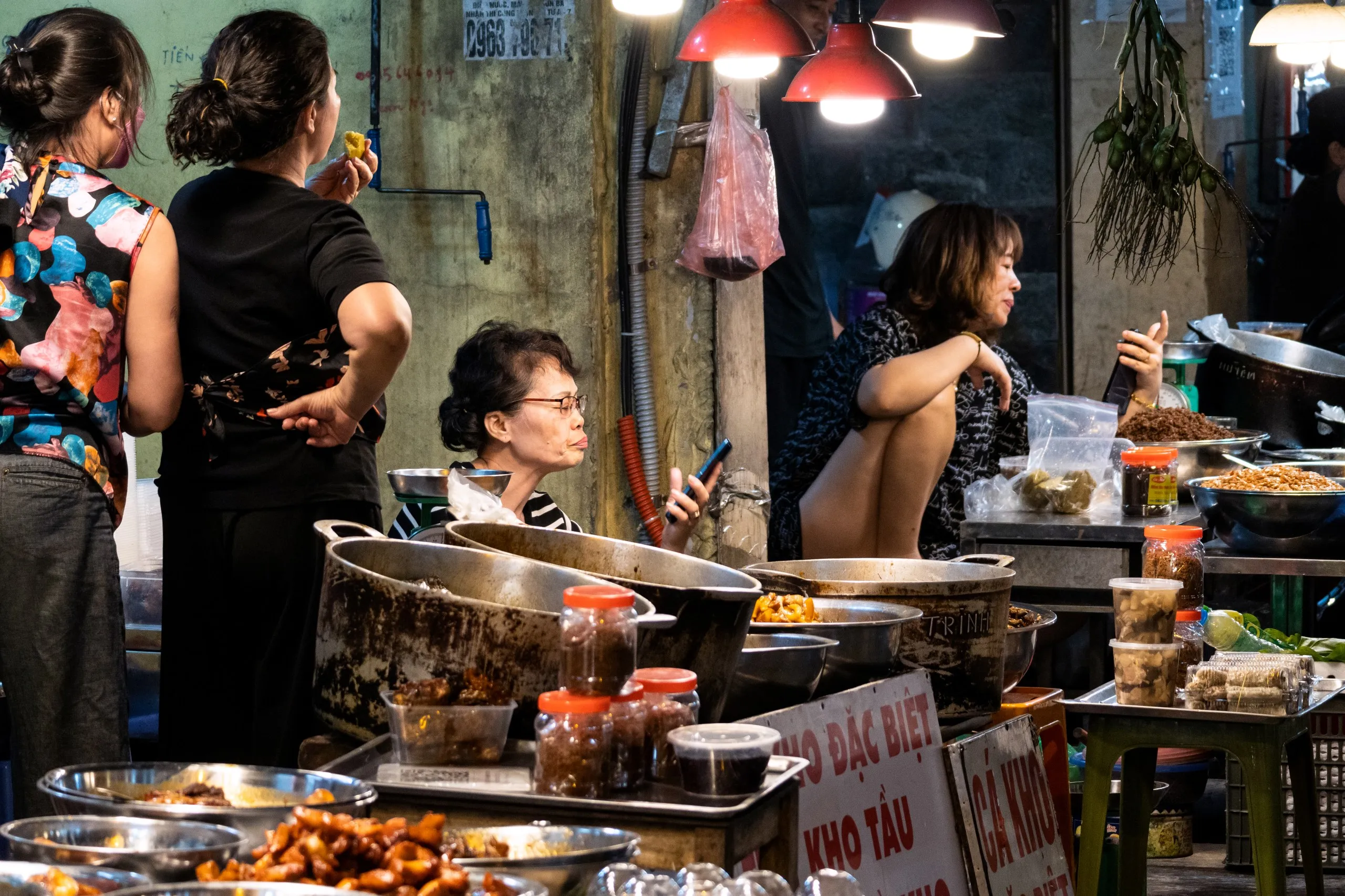 Street food vendors lighting up a night market in Hanoi’s Old Quarter – a must experience when deciding where to go in Vietnam.
Street food vendors lighting up a night market in Hanoi’s Old Quarter – a must experience when deciding where to go in Vietnam.
Discover the Best of What to Do in Downtown Denver – Your Ultimate Guide
Discover the Best Brunch in Denver – A Local’s Guide
Top 10 Places to Visit in Nevada with Family for an Epic Trip
Hanoi is an exhilarating assault on the senses – perpetually noisy with the hum of motorbikes, yet undeniably beautiful with its tree-lined boulevards and historic architecture. This thousand-year-old capital, established on a bend of the Red River, is a repository of history, culture, and dynamic urban life. Exploring where to go in Vietnam must include Hanoi.
The heart of the city beats strongest in the Old Quarter, a maze of narrow streets, each traditionally dedicated to a specific trade. Here, you’ll find ancient temples nestled beside bustling shops, vibrant markets, and endless street food stalls. Mastering the art of navigating the motorbike traffic is part of the Hanoi experience.
Beyond the Old Quarter, discover the ochre-hued elegance of French colonial villas, pay respects at Ho Chi Minh’s Mausoleum, visit the serene Temple of Literature (Vietnam’s first university), explore the Hoa Lo Prison Museum (the “Hanoi Hilton”), and gain insight into the country’s ethnic diversity at the Vietnam Museum of Ethnology. The food scene is legendary, from a steaming bowl of pho for breakfast to bun cha for lunch and countless snacks found while wandering.
Ha Giang: Gateway to Vietnam’s Rugged North
 Children playing in the dramatic mountain landscape of Ha Giang province, a remote area perfect for adventurous travel in Vietnam.
Children playing in the dramatic mountain landscape of Ha Giang province, a remote area perfect for adventurous travel in Vietnam.
For the adventurous traveler asking “Where To Go In Vietnam” seeking stunning natural beauty and authentic cultural encounters, Ha Giang in the far north is an essential answer. Bordering China, this region boasts an otherworldly landscape dominated by dramatic sugarloaf karst peaks, winding mountain passes (like the famous Ma Pi Leng Pass), and vibrant green rice paddies carved precariously into steep slopes.
This is a land of ethnic minorities, including the Red Dzao and Flower Hmong, whose traditional ways of life, colorful markets, and intricate weaving traditions remain strong. Exploring Ha Giang often involves undertaking the famous ‘Ha Giang Loop’ by motorbike, a challenging but immensely rewarding journey through breathtaking scenery. Visit the former palace of the Hmong king, a relic of the region’s opium farming past. While in the north, consider a stop in the dazzling terraced rice field region of Mu Cang Chai, offering equally spectacular views. Eco-stays and homestays provide opportunities to connect with local communities and experience rural Vietnam up close.
Pu Luong and Mai Chau: Tranquil Valley Escapes
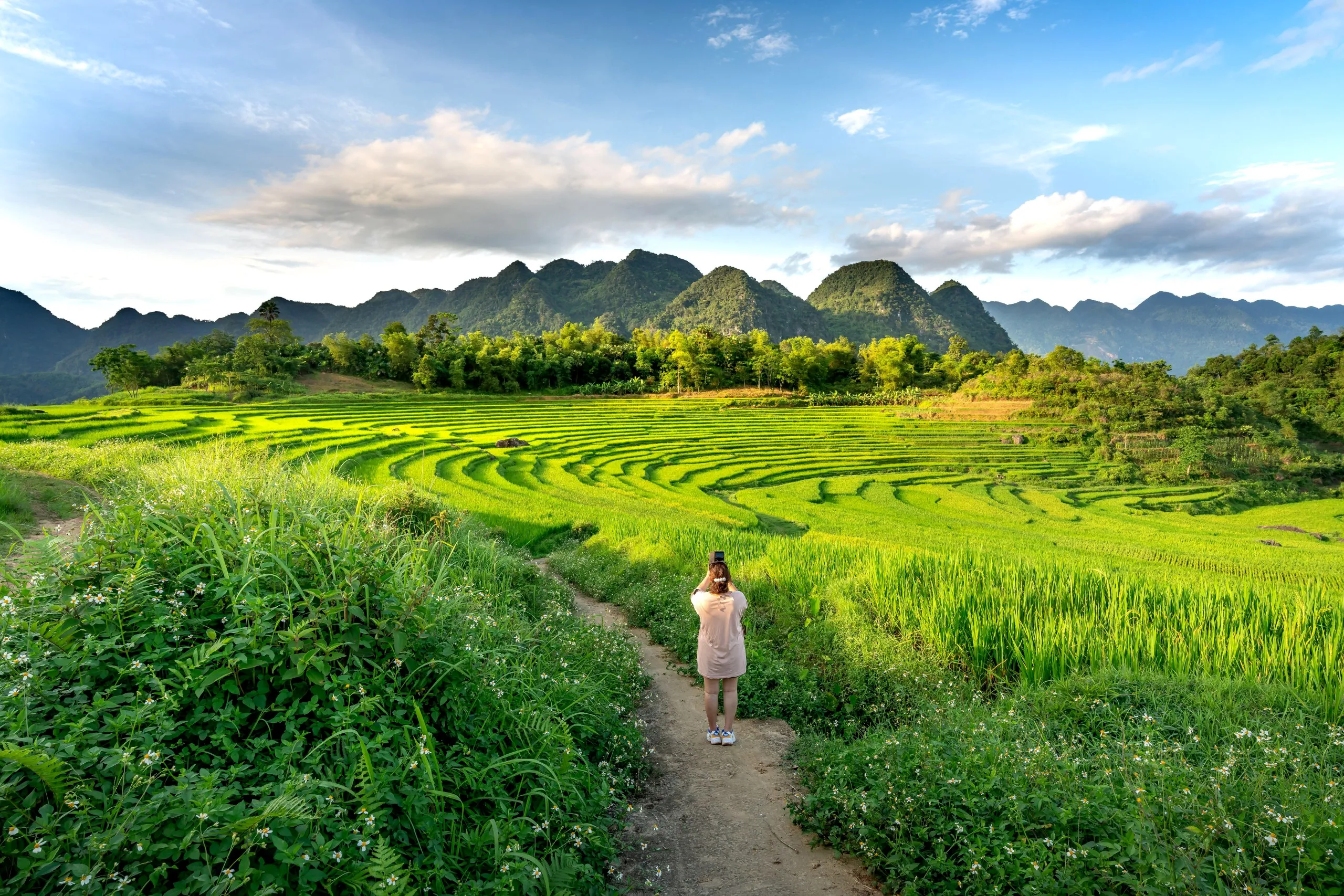 A visitor capturing the serene beauty of the tiered rice terraces in Pu Luong nature reserve, a picturesque destination in Vietnam.
A visitor capturing the serene beauty of the tiered rice terraces in Pu Luong nature reserve, a picturesque destination in Vietnam.
Not far from the intensity of Hanoi, the Pu Luong Nature Reserve and the Mai Chau Valley offer idyllic retreats into Vietnam’s rural heartland, characterized by luminous green rice paddies and serene landscapes. These areas are perfect answers for those wondering “Where To Go In Vietnam” for peaceful trekking and cultural immersion.
In Pu Luong, eco-retreats and homestays are scattered amid the terraces and forests. Trekking trails lead past the traditional homes and orchards of the Muong people. A unique experience is cruising down a river on a traditional bamboo raft, observing the landscape woven with traditional water wheels used for irrigation.
The reserve is also a haven for wildlife, potentially spotting species like the rare Asian black bear, Owston’s palm civet, and the endangered Delacour’s langur. Just north, the Mai Chau Valley presents a similarly beautiful, serene landscape of rice paddies, home primarily to White Thai ethnic communities known for their stilt houses. Staying in a traditional homestay or a resort built in harmony with the landscape offers a deep connection to the area.
Bai Tu Long Bay (Halong Bay): Beyond the Crowds
 Bai Tu Long Bay, a quieter and equally stunning alternative to the main Halong Bay area, offering serene cruising experiences in Vietnam.
Bai Tu Long Bay, a quieter and equally stunning alternative to the main Halong Bay area, offering serene cruising experiences in Vietnam.
Halong Bay, a UNESCO World Heritage site, is a quintessential destination when considering where to go in Vietnam. Its ethereal beauty, with thousands of craggy limestone outcrops rising dramatically from emerald waters, is world-renowned. Boats, from traditional junks to luxurious vessels, navigate these magical waters, which can transform under different weather conditions, from crisp blue skies to mystical dense fog.
To truly appreciate the enchantment and escape the day-trip and one-night boat crowds, venture further into Bai Tu Long Bay, located to the northeast. This area, part of the larger Halong Bay system, offers equally spectacular karst scenery but with fewer boats, providing a more peaceful and magical experience. Staying on a boat for at least two nights allows you to explore more remote coves, hidden beaches, limestone caves, and floating fishing villages. Activities like kayaking, swimming, and simply soaking in the quiet grandeur become highlights of a multi-day cruise here.
Hue and the DMZ: Imperial Grandeur and War History
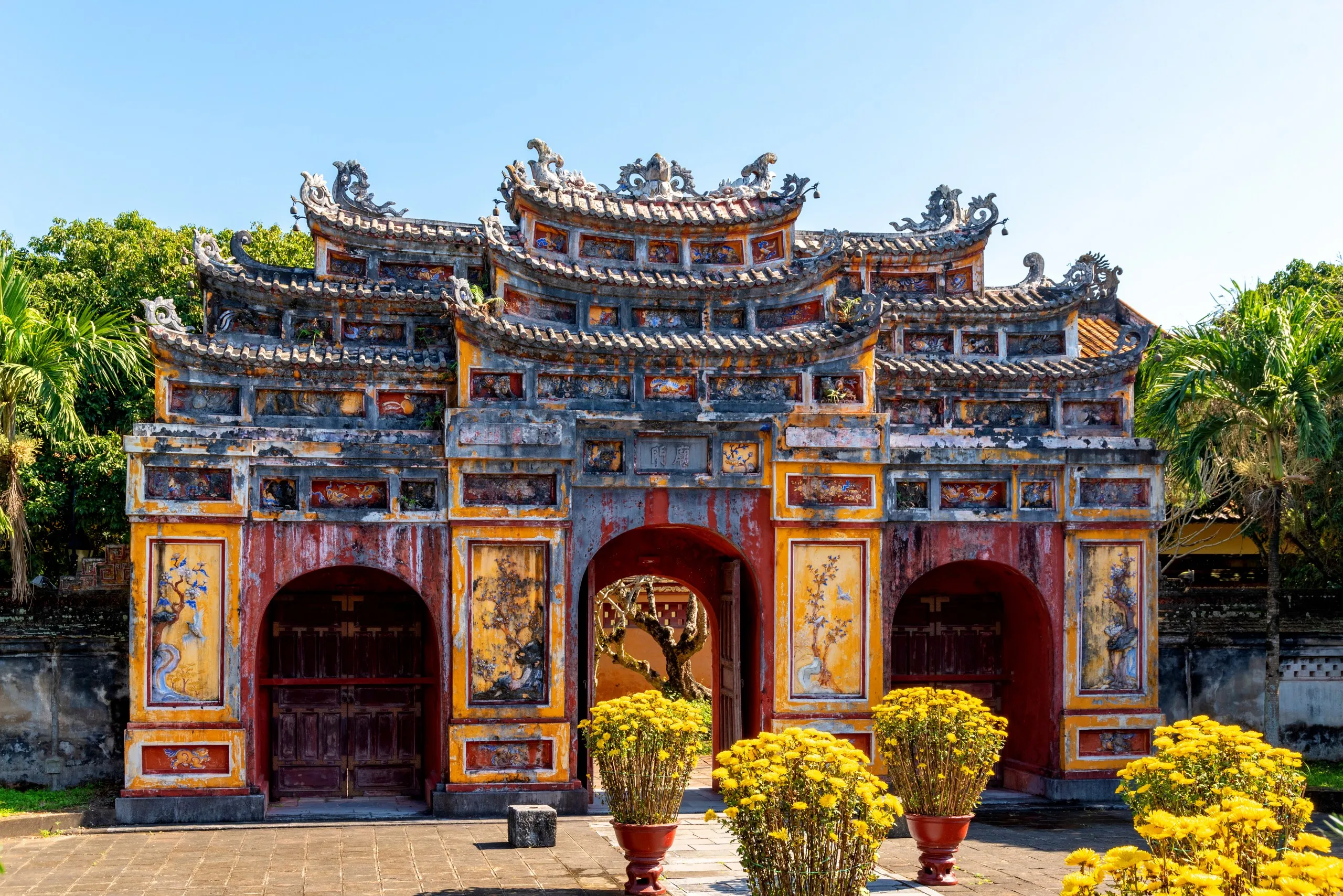 An ornate gate within the Imperial City of Hue, Vietnam, showcasing the architectural legacy of the Nguyen dynasty.
An ornate gate within the Imperial City of Hue, Vietnam, showcasing the architectural legacy of the Nguyen dynasty.
Hue, often bypassed for the more tourist-friendly Hoi An in central Vietnam, is a city steeped in history and culture, a vital stop when considering where to go in Vietnam to understand its imperial past and wartime struggles. It served as the political and cultural capital of the Nguyen emperors, Vietnam’s last imperial dynasty, from 1802 to 1945.
The centerpiece is the Imperial City, a vast complex modeled on Beijing’s Forbidden City, featuring gilded palaces, temples, and gates, though parts were heavily damaged during the Vietnam War. The emperors lived lives of elaborate splendor within these walls. Outside the citadel, along the winding Perfume River, lie the magnificent and geomantically designed imperial mausoleums, each a unique architectural masterpiece reflecting the personality of the emperor it commemorates.
Hue is also celebrated for its sophisticated imperial cuisine, said to comprise over a thousand dishes, many of which can still be sampled today. From Hue, you can explore the Demilitarized Zone (DMZ), which marked the temporary border between North and South Vietnam during the war, offering a sobering look at 20th-century history.
Danang and China Beach: Coastal Charm and Ancient Echoes
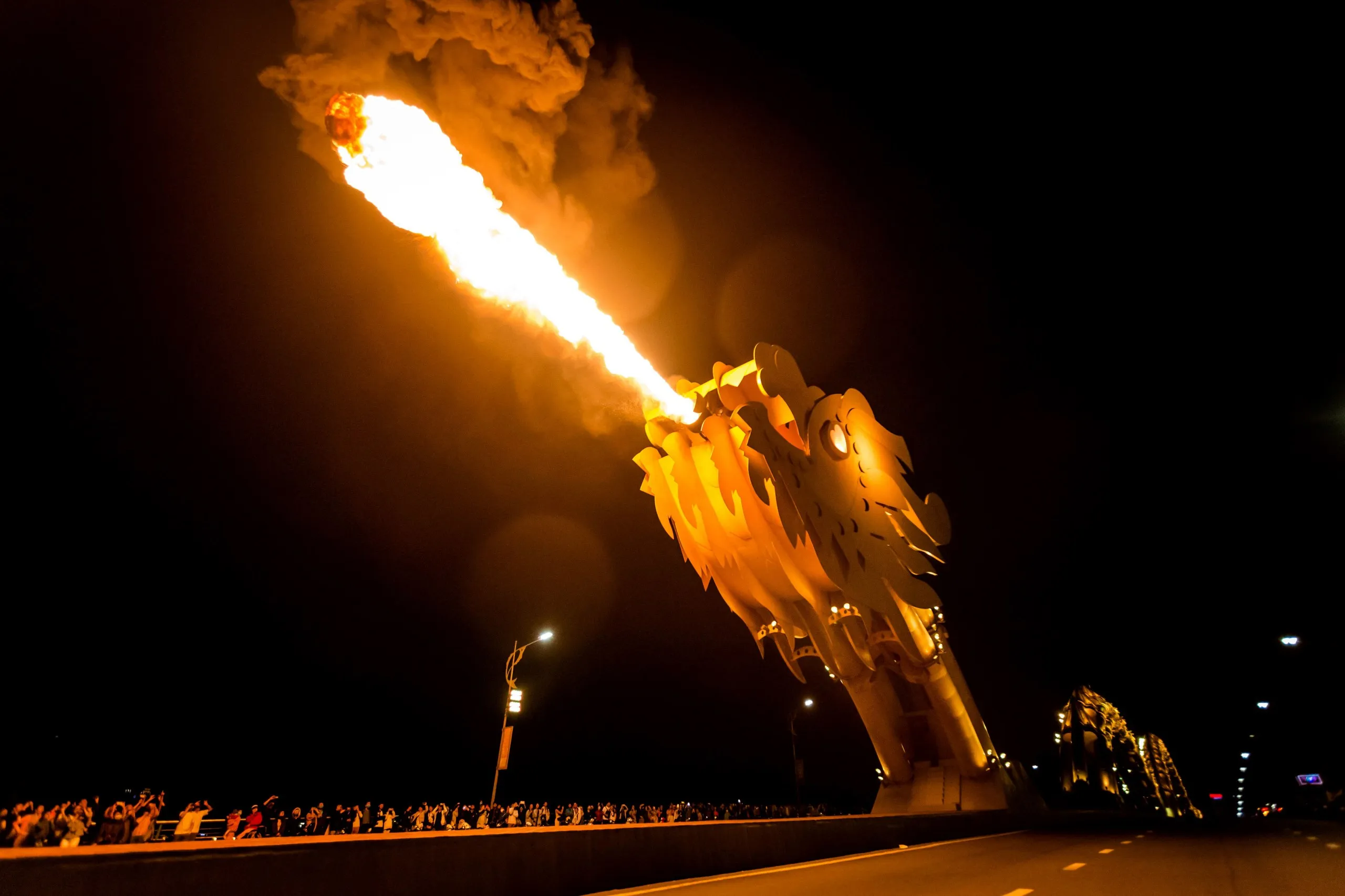 The distinctive fire-breathing Dragon Bridge illuminating the skyline of Danang, a modern city and coastal hub in Vietnam.
The distinctive fire-breathing Dragon Bridge illuminating the skyline of Danang, a modern city and coastal hub in Vietnam.
Danang, a dynamic coastal city, and its famous stretch of coastline known as China Beach offer a blend of wartime history, luxurious resorts, and nearby ancient wonders. China Beach, an 18-mile curve of golden sand, gained notoriety as a rest and recreation spot for American GIs during the Vietnam War. Today, it’s home to some of Vietnam’s most luxurious beachfront hotels.
Beyond the beautiful beach, Danang is a cultural gateway. The Museum of Cham Sculpture houses an unparalleled collection of sandstone carvings from the ancient Cham kingdom, an Indianized culture that once flourished in central Vietnam. Nearby are the UNESCO-protected ruins of My Son Sanctuary, the spiritual capital of the Cham, featuring impressive temple towers set in a jungle valley – a must-see for history enthusiasts deciding where to go in Vietnam. Danang city itself is modern and rapidly developing, known for its impressive bridges, including the iconic fire-breathing Dragon Bridge. The Marble Mountains, a cluster of five hills with caves, tunnels, and Buddhist shrines, are also a popular nearby attraction offering panoramic views.
Hoi An: The Enchanting Ancient Town
 Visitors exploring the lantern-lit streets of the old town of Hoi An, a charming UNESCO World Heritage site in central Vietnam.
Visitors exploring the lantern-lit streets of the old town of Hoi An, a charming UNESCO World Heritage site in central Vietnam.
Yes, Hoi An is popular with tourists, but its undeniable charm makes it a mandatory stop when considering where to go in Vietnam. This ancient port town, once a major trading hub from the 15th to 19th centuries, is beautifully preserved and designated a UNESCO World Heritage site.
The town is a living museum, featuring a unique blend of architectural styles – Chinese temples, Japanese merchant houses (including the iconic Japanese Covered Bridge), and old Vietnamese tube houses. The streets, particularly along the Thu Bon River, are lined with single-storey, ochre-colored buildings and famously illuminated by colorful lanterns at night, creating a magical atmosphere.
Hoi An is also famous for its incredible number of tailor shops, offering bespoke clothing made quickly and affordably. The culinary scene is a highlight, featuring local specialties like Cao Lau (a unique noodle dish) and White Rose dumplings, alongside some of the country’s best banh mi. Just a short drive away, An Bang beach provides a pleasant spot for relaxation after exploring the historic streets.
Ninh Van Bay: Secluded Coastal Luxury
 The pristine beach and turquoise waters of Ninh Van Bay, a secluded luxury getaway near Nha Trang, Vietnam.
The pristine beach and turquoise waters of Ninh Van Bay, a secluded luxury getaway near Nha Trang, Vietnam.
If your quest for “Where To Go In Vietnam” involves escaping the crowds for a luxurious, secluded beach experience, Ninh Van Bay, near the bustling resort city of Nha Trang, is an ideal choice. Tucked away on a peninsula north of the city, this bay offers a tranquil hideaway surrounded by lush hills and pristine coastline.
This destination is synonymous with high-end, barefoot luxury resorts that blend seamlessly into the natural environment. Villas are often nestled among trees or perched on giant granite boulders, offering privacy and stunning sea views, many with private plunge pools. The focus here is on relaxation, natural beauty, and personalized service. Days can be spent lounging on the sugar-soft sand, snorkeling or diving in the clear waters, or exploring the peninsula’s waterfalls and forests. The feeling is one of being truly removed from the everyday world, with nothing but the sound of waves and nature for company.
Dalat: The City of Eternal Spring
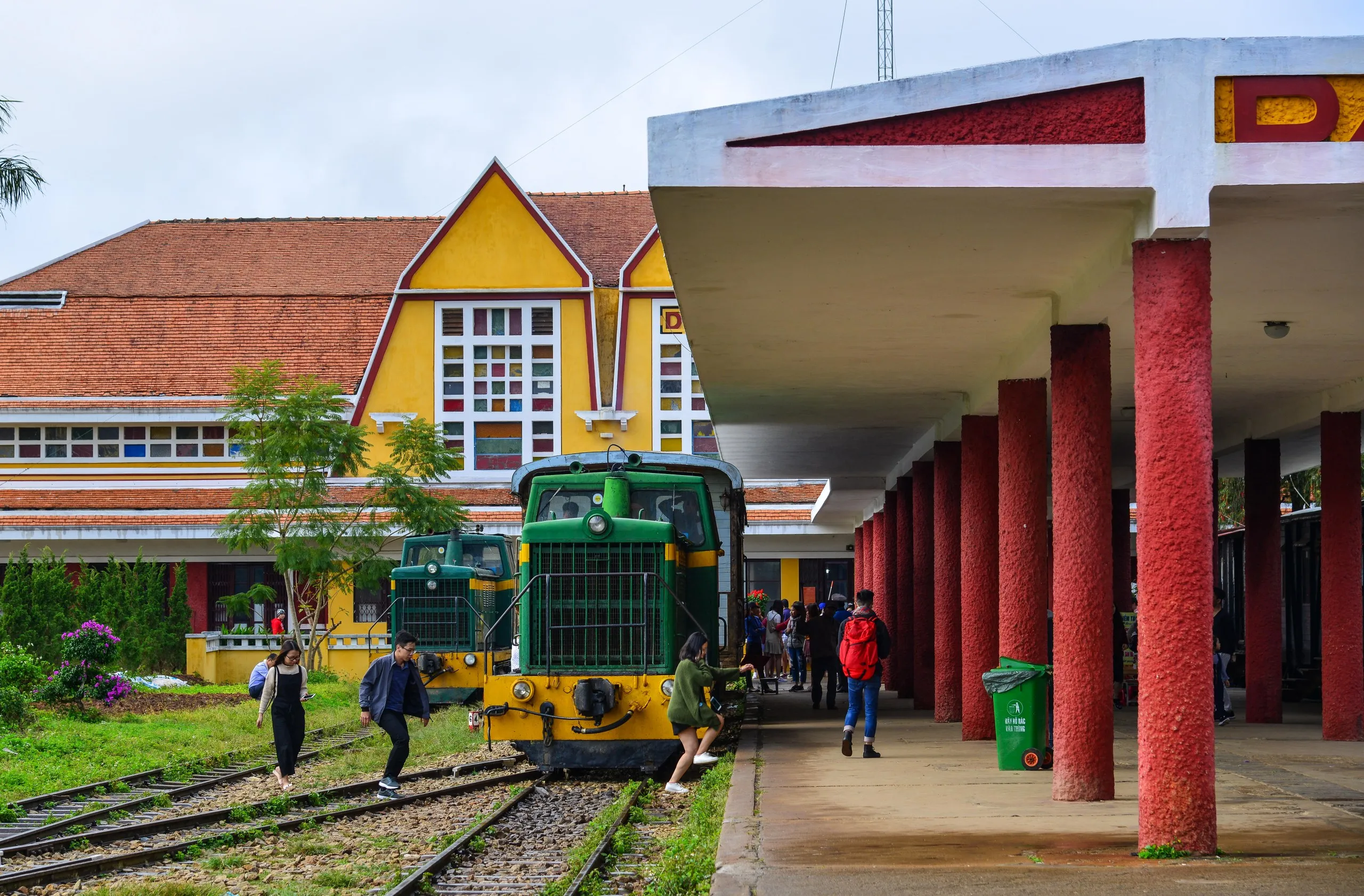 A charming 1930s railway station in Dalat, Vietnam, reflecting the city’s unique French colonial heritage.
A charming 1930s railway station in Dalat, Vietnam, reflecting the city’s unique French colonial heritage.
Dalat, nestled in the pine-scented Central Highlands, is a quirky and charming city that stands apart from much of Vietnam. Established by the French as a hill station to escape the lowland heat, it retains a distinct European feel, making it an interesting addition when deciding where to go in Vietnam.
The city is characterized by its cool climate, a central lake, surrounding hills dotted with early 20th-century homes and villas, extensive flower gardens (it’s known as the City of Flowers), and picturesque waterfalls. Today, Dalat has a lively atmosphere with numerous cafes, bars, and restaurants. It serves as a base for exploring unusual attractions like the unconventional architecture of the “Crazy House,” quirky themed gardens, and even a golf course. The old French-built railway station, reminiscent of a Wes Anderson film set, is a must-visit. Dalat is also a significant agricultural region, particularly known for coffee, fruits, and vegetables, offering opportunities to visit farms and enjoy local produce.
Ho Chi Minh City: The Energetic Southern Metropolis
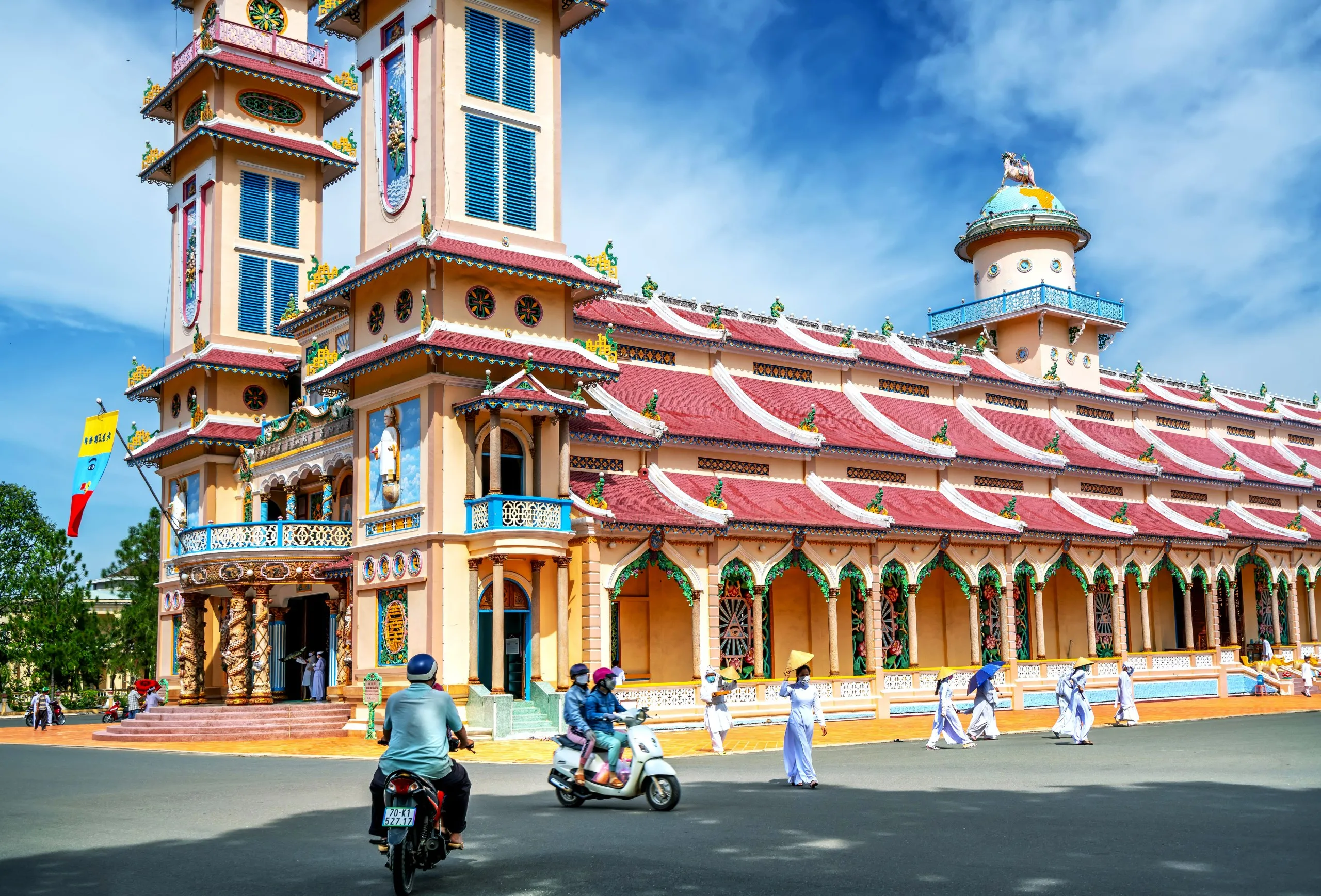 The distinctive architecture of the Cao Dai cathedral at Tay Ninh, a fascinating cultural site near Ho Chi Minh City, Vietnam.
The distinctive architecture of the Cao Dai cathedral at Tay Ninh, a fascinating cultural site near Ho Chi Minh City, Vietnam.
Ho Chi Minh City (formerly Saigon) is a powerhouse of energy and commerce, a sprawling southern metropolis home to over nine million people and an estimated eight million motorbikes. Including HCMC is essential when considering where to go in Vietnam for a taste of dynamic urban life, modern history, and incredible food.
The city pulses with infectious energy, fueled by a booming economy, a growing craft beer and cocktail scene, and an unparalleled street food culture. While two decades ago it was relatively low-rise, today it’s dominated by a growing skyline of modern skyscrapers. Despite its rapid modernization, traces of its past remain. Explore the city’s key historical sites, such as the Reunification Palace, the War Remnants Museum (a powerful and moving experience), the Notre Dame Cathedral, and the Central Post Office. A thrilling way to experience the city is on the back of a motorbike with a local guide, navigating the chaotic traffic.
Day trips from the city include visiting the Cu Chi Tunnels, an extensive underground network used by the Viet Cong during the war, and the vibrantly colorful Cao Dai Holy See at Tay Ninh, the center of the unique Cao Dai religion. The food and coffee scene here is among the best in Vietnam.
Mekong Delta: Life on the Waterways
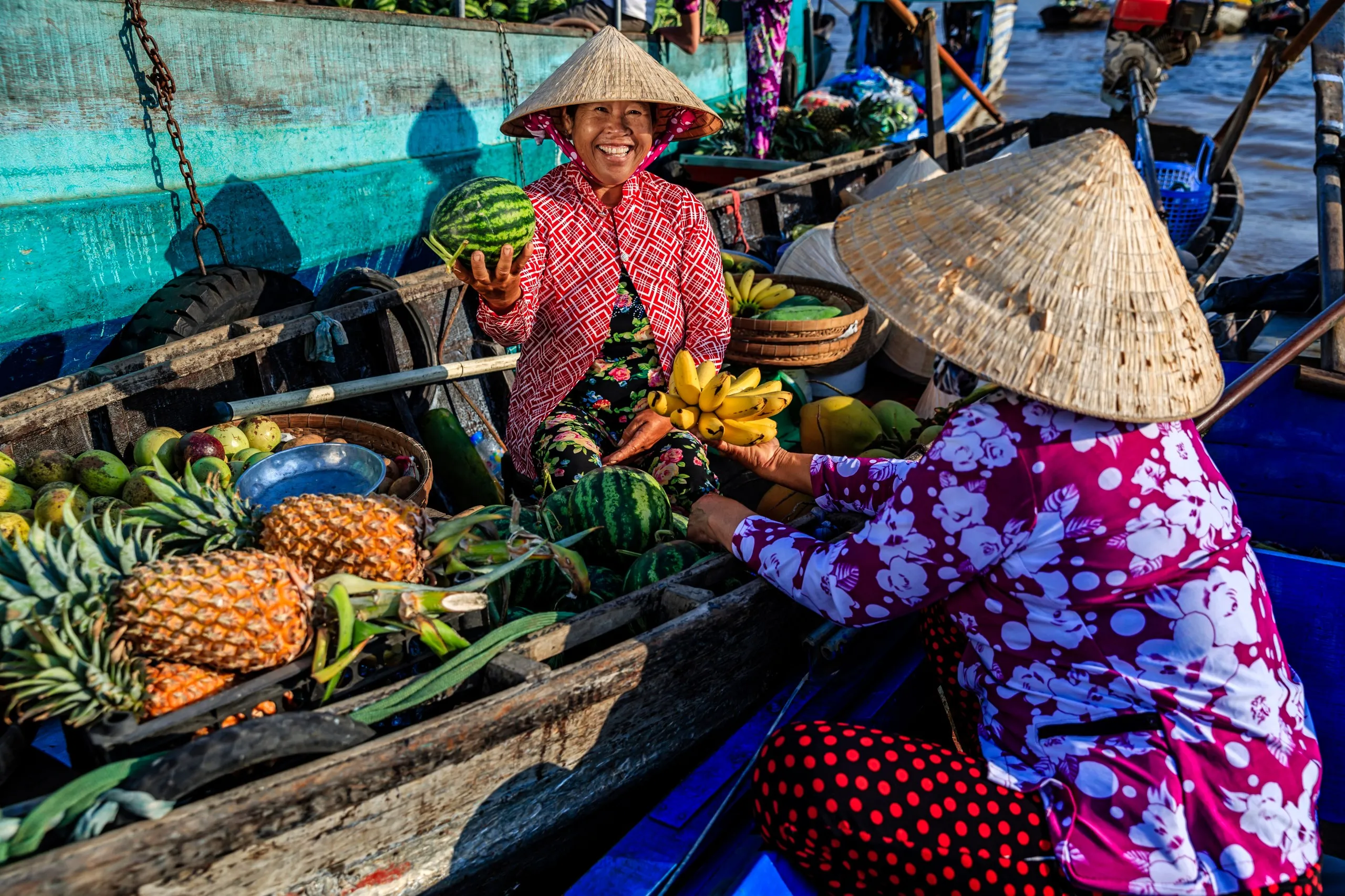 A vendor selling fresh fruit from their boat at a bustling floating market on the Mekong Delta, showcasing the unique riverine lifestyle in Vietnam.
A vendor selling fresh fruit from their boat at a bustling floating market on the Mekong Delta, showcasing the unique riverine lifestyle in Vietnam.
The Mekong Delta, often referred to as Vietnam’s rice bowl, is where the mighty Mekong River fragments into numerous channels and tributaries before meeting the sea. Exploring this region offers a glimpse into a unique riverine way of life, a distinct cultural mix, and lush agricultural landscapes – a fascinating addition to any list of where to go in Vietnam.
Life here revolves around the water. Highlights include visiting vibrant floating markets, where vendors sell goods directly from their boats, although these are slowly becoming less common. Exploring the waterways by boat reveals traditional stilt houses, local workshops producing coconut candy or rice paper, temples and churches reflecting the diverse communities, and market gardens overflowing with tropical fruits like coconuts, bananas, and mangoes, as well as vast rice fields.
The delta’s history is also rich, including remnants of the Vietnam War like the Xeo Quyt forest bunkers used by the Viet Cong. The culture is a fascinating blend of Vietnamese, Khmer, and Cham influences. The focus of a trip here is less on specific landmark sites and more on immersing yourself in the rhythm of life on the water, sampling delicious local produce and seafood.
Con Dao Archipelago: History and Pristine Nature
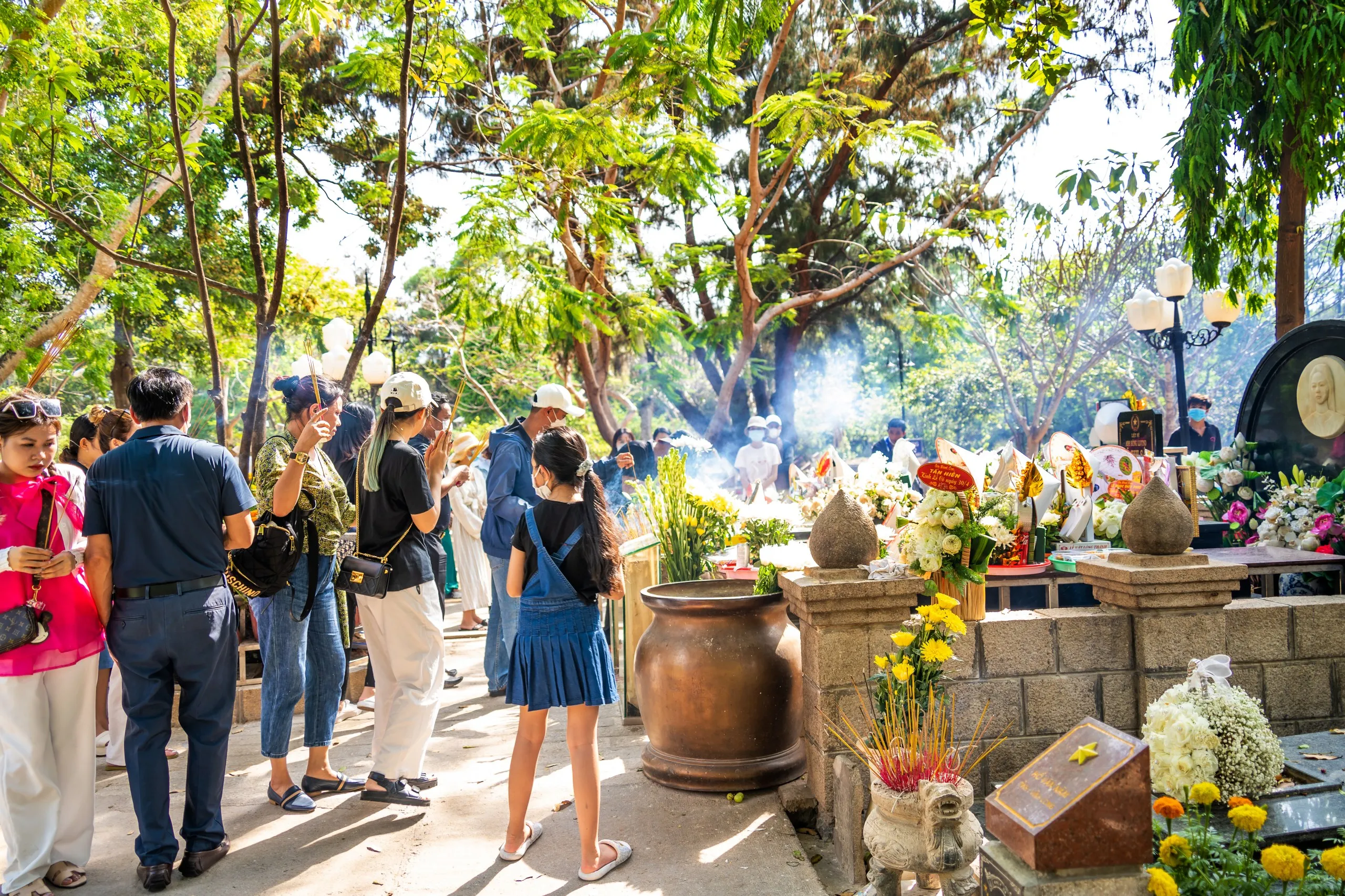 Visitors walking through the cemetery on Con Dao island, a place of reflection on the island’s complex history in Vietnam.
Visitors walking through the cemetery on Con Dao island, a place of reflection on the island’s complex history in Vietnam.
For those seeking a destination where natural beauty meets profound history, the Con Dao archipelago, a remote collection of islands off Vietnam’s southern coast, provides a unique answer to “Where To Go In Vietnam.” Once notorious as a brutal prison island under both French and American rule, today it is a national park and a recognized wetland area (Ramsar site).
The islands are renowned for their stunning natural environment – lush forests, dramatic coastlines, beautiful secluded beaches, and vibrant marine life. It is one of Vietnam’s most important locations for nesting sea turtles, with opportunities to witness hatchlings being released during the right season.
Activities include hiking through the national park, snorkeling and diving in the clear waters teeming with coral and fish, relaxing on pristine sands, and watching the squid boats light up the sea at night. Alongside its natural wonders, Con Dao confronts its dark past. Visit the former prison sites and the cemetery of Vietnamese martyrs, a place of deep national significance where locals visit, believing the spirits of the martyrs reside. The blend of tragic history and breathtaking nature makes Con Dao a uniquely compelling destination.
Your Journey Across Vietnam
Vietnam offers an astonishing range of experiences, catering to every type of traveler. From the historic streets of Hanoi and the majestic karst landscapes of Halong Bay and Ha Giang, to the imperial elegance of Hue, the ancient charm of Hoi An, the vibrant energy of Ho Chi Minh City, the tranquil beauty of the Mekong Delta, and the secluded shores of Con Dao, there’s a corner of Vietnam waiting to be discovered.
Deciding where to go in Vietnam allows you to tailor your trip to your interests, whether it’s delving into history, indulging in world-class cuisine, trekking through stunning natural scenery, or simply relaxing on beautiful beaches. Each region offers a unique perspective on this resilient and fascinating country, promising a journey filled with rich cultural encounters, unforgettable flavors, and breathtaking sights. Start planning your adventure across Vietnam’s diverse landscapes and vibrant cultures today.
